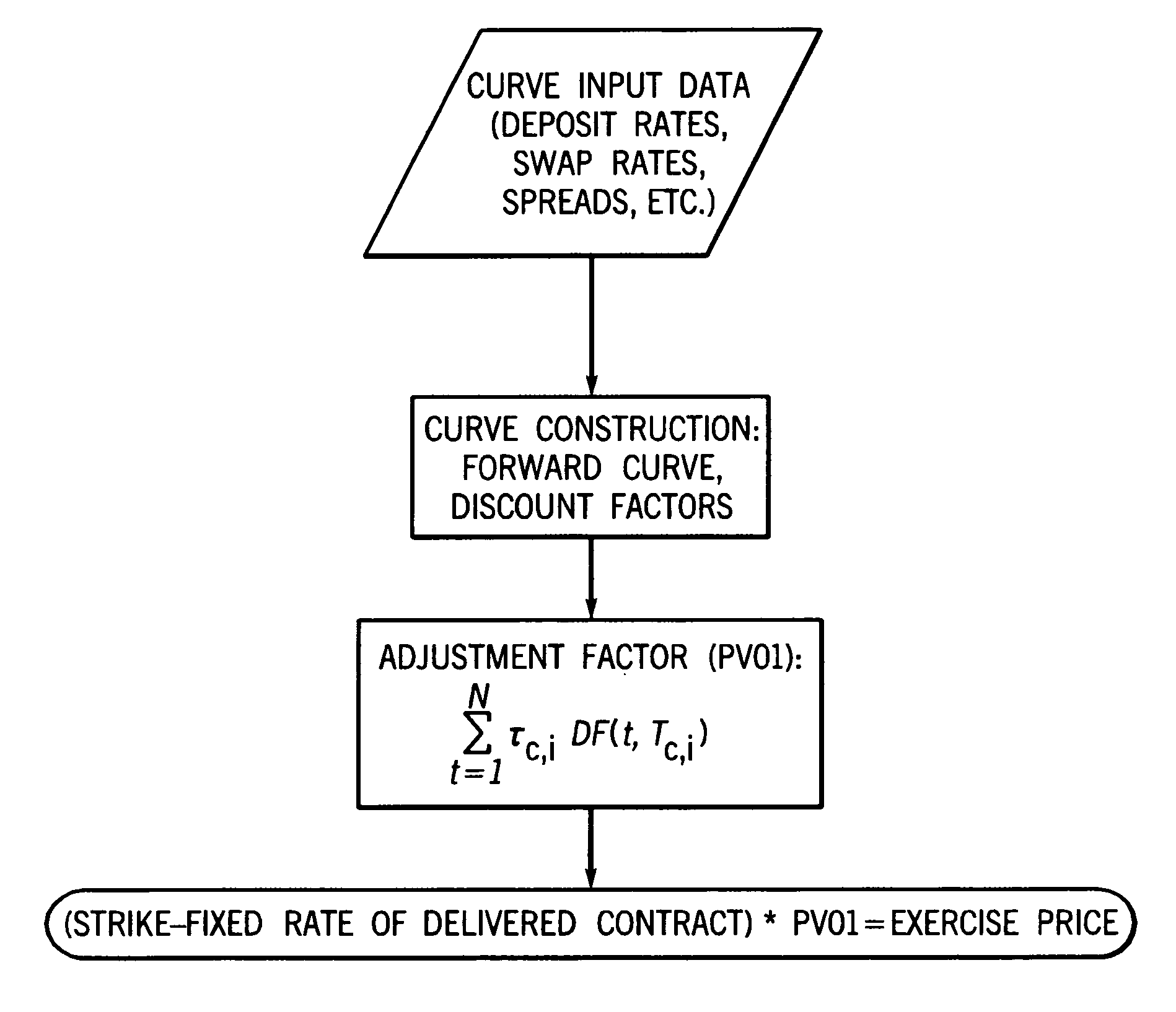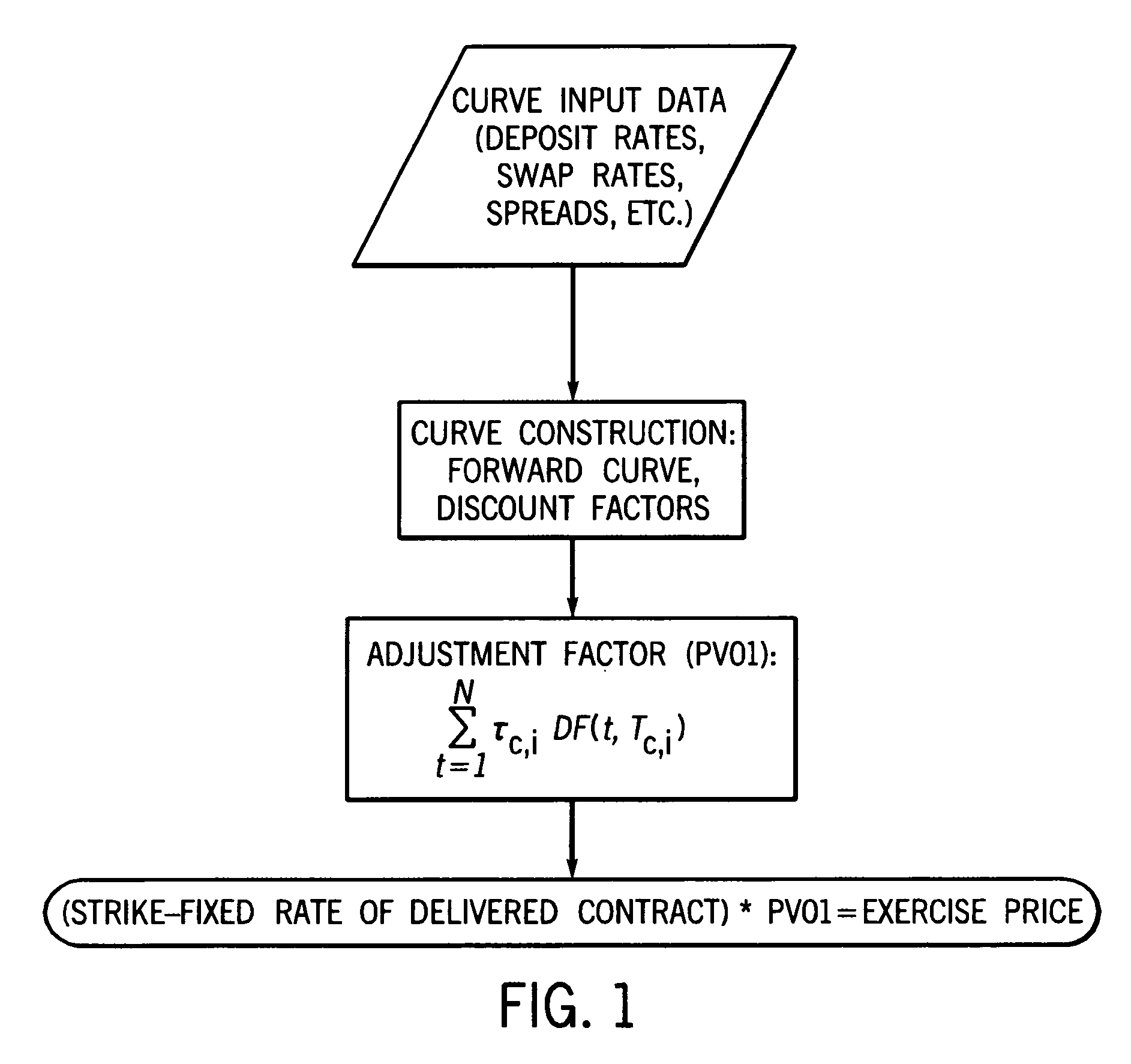Flexible-rate, financial option and method of trading
a financial option and flexible rate technology, applied in the field of financial instruments, can solve the problems of no clear standard market convention for central counterparties to accommodate off-market swaps, exposure to the credit risk of the other party, and counterparty risk, so as to enhance the liquidity of these underlying benchmark financial instruments, reduce the risk of default, and mitigate the granularity issue
- Summary
- Abstract
- Description
- Claims
- Application Information
AI Technical Summary
Benefits of technology
Problems solved by technology
Method used
Image
Examples
example 1
[0101]This example shows that a flexible-rate option can be exercised into a standardized coupon financial instrument using PV01 to determine the exercise price, as described above in Equation 3. This example is a payer option.
[0102]Consider a forward starting 2-year LIBOR interest rate swap with notional amount of $1,000,000. Assume that the discounting curve is an OIS curve, and the forward curve is a LIBOR curve, though construction of a forward curve may not be necessary for the application of the invention in this example. A set of LIBOR swap rates, Eurodollar rates, forward rate agreement rates, LIBOR rates, Treasury rates and swap spreads, etc. are used to construct the OIS curve and LIBOR curve. A list for multiple options based on this underlying swap with a common coupon value, might be:
Listed Payer (Receiver) Option forTrading Today (price negotiated inUnderlying Financial Instrumentpremium)Delivered Upon ExerciseRight to pay (receive) fixed at a rate ofJun. 20, 2012 Effe...
example 2
[0107]This example shows that a flexible-rate option can be exercised into a standardized coupon financial instrument using PV01 as the adjustment factor, as described above in Equation 3, this time for a receiver option.
[0108]Consider a forward starting 10-year LIBOR interest rate swap with notional amount of $1,000,000. Assume that the discounting curve is an OIS curve, and the forward curve is a LIBOR curve, though construction of a forward curve may not be necessary for the application of the invention in this example. A set of LIBOR swap rates, Eurodollar rates, forward rate agreement rates, LIBOR rates, Treasury rates and swap spreads, etc. are used to construct the OIS curve and LIBOR curve. A list for multiple options based on this underlying swap with a common coupon value, might be:
Listed Payer (Receiver) Option forTrading Today (price negotiated inUnderlying Financial Instrumentpremium)Delivered Upon ExerciseRight to pay (receive) fixed at a rate ofSep. 19, 2012 Effective...
example 3
[0112]This example shows that a flexible-rate option can be exercised into a standardized coupon financial instrument using DV01 as an adjustment factor consistent with Equation 4, this time for a receiver option.
[0113]Consider a forward starting 10-year LIBOR interest rate swap with notional amount of $1,000,000. Assume that the discounting curve is an OIS curve, and the forward curve is a LIBOR curve. A set of LIBOR swap rates, Eurodollar rates, forward rate agreement rates, LIBOR rates, Treasury rates and swap spreads, etc. are used to construct the OIS curve and LIBOR curve. A list for multiple options based on this underlying swap with a common coupon value, might be:
Listed Payer (Receiver) Option forTrading Today (price negotiated inUnderlying Financial Instrumentpremium)Delivered Upon ExerciseRight to pay (receive) fixed at a rate ofSep. 19, 2012 Effective Date, 3.300% on a par financial instrument10 year tenor, 3.500% coupon, of 10 years tenor, option expirationinvention-det...
PUM
 Login to View More
Login to View More Abstract
Description
Claims
Application Information
 Login to View More
Login to View More - R&D
- Intellectual Property
- Life Sciences
- Materials
- Tech Scout
- Unparalleled Data Quality
- Higher Quality Content
- 60% Fewer Hallucinations
Browse by: Latest US Patents, China's latest patents, Technical Efficacy Thesaurus, Application Domain, Technology Topic, Popular Technical Reports.
© 2025 PatSnap. All rights reserved.Legal|Privacy policy|Modern Slavery Act Transparency Statement|Sitemap|About US| Contact US: help@patsnap.com



